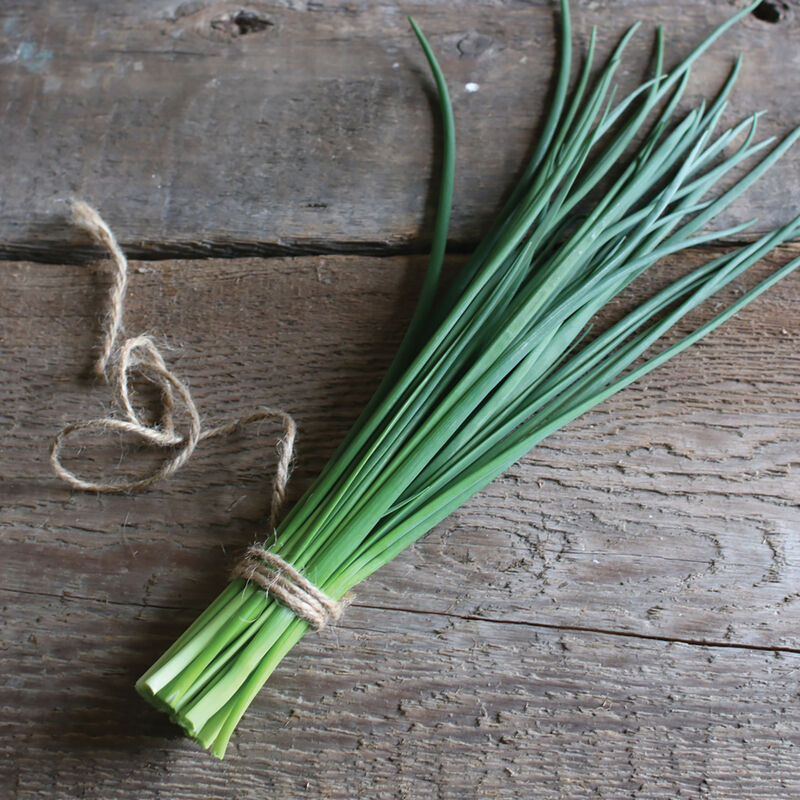Olive Seed Company
Herb 'Chives'
Herb 'Chives'
Couldn't load pickup availability
Allium schoenoprasum — Staro Chive
Staro is a robust chive variety with thick, upright leaves that hold their shape well after cutting. Known for its strong onion-like flavour, it’s excellent for fresh use in salads, baked potatoes, soups, and egg dishes, or dried for winter storage. Lavender-pink flowers bloom in summer, attracting bees and providing mild edible blossoms. Cold-hardy and perennial, Staro chives thrive in full sun and well-drained soil, returning reliably year after year.
DETAILS:
QTY: 100
SITE: Sun/Part Shade
TYPE: Perennial
DEPTH: 1/4"
GERMINATION: 7-14 Days at 18 - 21°C
MATURITY: 75-85 Days
HEIGHT: 12-18"
SPACING: 2-3 plants every 2-8"
HOW TO GROW:
Planting:
-
When to Plant: You can start chives from seed indoors 6-8 weeks before the last frost, or direct sow them outdoors once the soil has warmed in late spring.
-
Where to Plant: Chives thrive in a location with full sun (6-8 hours daily) but will tolerate some light shade, though this may reduce flowering. They are also well-suited for container gardening.
-
Sowing Seeds: Sow seeds about 1/4 inch deep. Chives often grow in clumps, so you can plant several seeds together in a small group. Once the seedlings are established, thin them so the clumps are about 6 inches apart.
Soil & Fertilizing:
-
Soil Preference: Chives prefer well-drained, fertile soil that is rich in organic matter. A slightly acidic to neutral pH (6.0-7.0) is ideal. They will tolerate most soil types as long as they are not waterlogged.
-
Fertilizing: Chives are not heavy feeders. If your soil is rich in compost, additional fertilizer may not be necessary. If you do fertilize, a light application of a balanced, all-purpose fertilizer once or twice during the growing season is sufficient.
Watering:
-
Keep the soil consistently moist, especially during germination and establishment. Once mature, chives are quite drought-tolerant, but regular watering will encourage a continuous supply of tender leaves. Ensure the soil drains well to prevent root rot.
Pests & Diseases:
-
Chives are known for their ability to deter pests due to their high sulfur content. They are generally resistant to most pests, but can occasionally be affected by aphids or thrips. These can be managed with a strong spray of water or insecticidal soap.
-
To prevent fungal diseases like powdery mildew, ensure the plants have good air circulation and avoid overwatering.
Harvesting:
-
For Leaves: You can begin harvesting chives once the plant is at least 6 inches tall. Use a sharp pair of scissors to snip the leaves from the base of the plant, about 1-2 inches above the soil line. Harvest from the outside of the clump to encourage new growth from the center. Do not cut more than one-third of the plant at a time.
-
For Flowers: The beautiful purple flowers are also edible and have a mild onion flavor. Harvest them when they are fully open.
-
Maintenance: To encourage new growth and prevent self-seeding (which can make the plant invasive), cut back the entire clump to about 2 inches from the ground after it flowers. Chives are best used fresh, as they do not dry well.
Tips for Success:
-
Dividing: Chives are perennials and will grow into larger clumps over time. To keep the plants healthy and productive, divide the clumps every 3-4 years in the spring.
-
Winter Care: In colder climates, chives will die back to the ground in the winter and regrow in the spring. You can dig up a small clump in the fall and bring it indoors to a sunny windowsill for a fresh supply of chives all winter long.
-
Companion Planting: Chives are excellent companion plants for carrots, tomatoes, and brassicas, as they are said to deter pests like aphids and carrot rust flies. Avoid planting them near beans and peas.
Shipping & Returns
Shipping & Returns

-
Free Shipping
Free Shipping on all orders in Canada over $125.00

